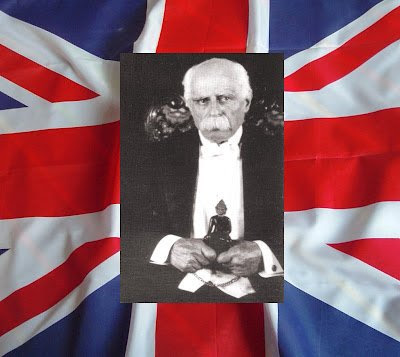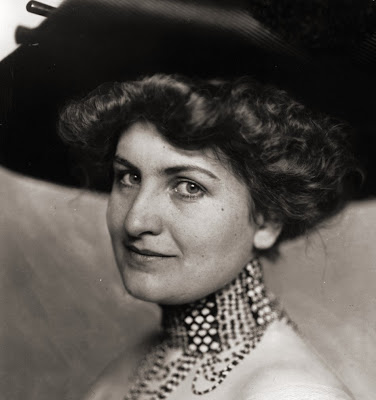Delicious irony in choice of Olympic anthem
Today’s opening ceremony for the 2012 London Olympics celebrates Britain’s ‘green and pleasant’ land, and the pageant, will, to quote the event’s artistic director Danny Boyle, create “a picture of ourselves as a nation”. Prominent among the music accompanying the ceremony is Parry’s inspired setting of William Blake, which includes the famous lines ‘Till we have built Jerusalem, In England’s green and pleasant land’. Over the years Parry's Jerusalem has become associated with what in 1930s France was known as “ethnic nationalism”, and tonight’s event with its village green, maypoles and last night of the Proms tableau seems set to perpetuate that association. But there is a delicious irony in the choice of Olympic anthem. Because Jerusalem, far from being the product of ethnic nationalism, started life as a rallying cry for a spiritual movement formed, to quote its founder, to appeal "to the whole of humanity... Hindus, Mohammedans, Buddhists... " And that is only the start of a long but remarkable story, because Sir Francis Younghusband, who commissioned Jerusalem in 1916 and died seventy years ago this week, was an evangelical Christian Colonel who led a bloody invasion of Tibet. But he went on to became a champion of spiritualism, free love, extraterrestrials, nature festivals, Indian gurus and multiculturalism, and, in sharp contrast to the corporate culture of the London Olympics, advocated a world where “the saint and sage are honoured above the richest capitalist”. In the montage above Sir Francis holds one of his prized possessions, a Buddha presented to him by the Ganden Tripa, the spiritual leader of the Gelug school of Tibetan Buddhism.
Sir Francis Younghusband's personal journey was truly remarkable. He was born in a hill station in India's North West Frontier region in 1863. His mother was an evangelical Christian and his father came from a military family and played a central role in setting up the Indian police force. Younghusband was educated at Clifton School, Bristol, an establishment which followed the principle pioneered by Dr Arnold at Rugby School of producing pupils dedicated to "a new Christian chivalry of patriotic service". After graduating with honours from the Royal Military Academy Sandhurst Younghusband was commissioned in the King's Dragoon Guards and returned to the land of his birth India, where he was eventually stationed at Rawal Pindi in the shadow of the mountains that were to feature so prominently in his life, the Himalayas. But soon Younghusband felt stifled by the rigidity of military life, and his life as both geographic and spiritual explorer started when he took a two month leave of absence to travel north to Turkestan. Here the political aspirations of Britain, China and Russia overlapped, and it was this overlap which was later to trigger Younghusbands' infamous invasion of Tibet.
His involvement in geopolitics then took him to the borders of Afghanistan. Here his Christian faith began to weaken and he started on a remarkable journey from evangelical Christianity to Eastern mysticism. But he was not yet free of Victorian values, and in 1897 he married an older woman whose horror of physical intimacy prompted him to tell her "We shall have a happier union if all that perfectly natural but lower part is eliminated from it”. However, despite a no-sex-before-death pact, his new wife was pregnant by the end of their Paris honeymoon. Sir Francis and Lady Younghusband are seen below with their daughter and the Maharajah of Kashmir.
Although Younghusband's Christain faith weakened his commitment to Britain's colonial ambitions remained intact, and he pursued a career in the border regions of India that moved seamlessly between the military and the political. At this time he was still committed to Britain’s colonial ambitions and he became a disciple of the social theorist and racial determinist John Beattie Crozier. In 1903 the Viceroy of India, Lord Curzon, appointed Younghusband to head an expedition to the frontier with Tibet as, to quote Lord Curzon "the Tibetans has been troublesome neighbours of late... and were now trying to have secret dealings with the Russians". The photo below shows Colonel Younghusband shortly before he left for Tibet.
The original objective of the expedition was to do no more than advance to Sikkim on the Tibetan border. But the headstrong Colonel Younghusband pressed on into Tibet, and, when negotiations with a representative of the thirteenth Dalai Lama collapsed, a confrontation ensued. This resulted in the notorious Chumi Shengo massacre in which 622 Tibetans died. Further killings and lootings of monasteries followed and by the time Younghusband's expedition reached Lhasa and imposed a penal peace treaty, 2800 Tibetans had been killed. Under the terms imposed by Younghusband but later rescinded by the British government, the Tibetans were to pay half a million pounds sterling in reparation and British troops could remain in Tibet until 1979. Below is the view in August 1904 as British troops enter Lhasa with the Potala Palace in the background.
Younghusband's highhanded leadership of the Tibet expedition met with an equivocal response in London. But despite this he was made a Knight Companion of the British Empire and appointed to the influential position of British resident in Kashmir. In the English press a Church of England bishop boasted that the Chumi Shengo massacre "will be the means of lighting up the torches of enlightement and Christianity in Tibet" but the effect on Younghusband was quite the opposite. After the peace treaty was signed he underwent a spiritual epiphany in the mountains of Tibet. With this came the revelation that is central to traditions ranging from Gnosticism to Islam, namely that men are at heart divine. Following this and while serving in Kashmir, he took the first tentative steps towards creating a new religion inspired by his epiphany; at this point his proto-religion drew on Christianity and Islam, coupled with his own vision of Empire. Francis Younghusband is seen below in Kashmir with his Ladakhi guide.
As his spiritual preoccupations increased, political diplomacy lost its appeal for the new knighted Sir Francis, and he resigned from his position in Kashmir to make an abortive foray into British politics. Following a near fatal road accident in Belgium he set out his proposals for the new religion in the book Within: Thoughts During Convalescence. In this he replaced the commonly accepted concept of a superior deity with a divine power residing within each individual. Writing in 1912 Younghusband introduced the distinctly New Age and counterculture concepts of free love and messages from aliens living on other planets, and went on to predict that a new spiritual leader would arrive in the form of a God-Child.
The outbreak of the First World War strengthened Sir Francis' religious fervour; he declared that "We are engaged in a spiritual conflict - a holy war - the Fight for Right” and that the spirit of the people “would respond to music, speech, song”, a belief that prompted him to form the Fight for Right movement. In a pioneering example of multiculturalism Younghusband resisted attempts to make the Fight for Right movement exclusively Christian: stating instead that he wanted it to appeal "to the whole of humanity... Hindus, Mohammedans, Buddhists..." This concept appealed to a wide constituency, and the supporters of the movement included a number of cultural celebrities, among them the novelist Thomas Hardy.
As part of a drive to widen the Fight for Right membership, Younghusband wanted a catchy rallying anthem. In 1916 the poet laureate and supporter of the movement Robert Bridges sent Hubert Parry, seen above, a copy of William Blake's 'Milton'. Bridges suggested that Parry compose "suitable, simple music to Blake's stanzas', and the result is history, or rather Jerusalem. Parry's setting of Blake was sung for the first time in March 1916 by three hundred members of Fight for Right conducted by Walford Davies in the Queen's Hall, then home to Henry Wood's Promenade concerts.
Jerusalem achieved the Edwardian equivalent of trending, but Fight for Right fared less well, and in 1917 a split opened in the movement between belligerent patriots and committed pacifists. As Fight for Right became increasingly miltaristic Parry withdrew Jerusalem as its anthem, and Younghusband sided with the pacifists and severed connections, and the movement was eventually wound up.
Despite this setback Younghusband continued his mystical explorations and between 1920 and 1930 published twelve books on a range of subjects. In one of these he took as his alter ego a mythical Indian Brahmin, and in another he anticipated aspects of the currently fashionable Gaia theory and of the worship of omniscient Mother figures such as Mother Meera. Elsewhere he extolled the virtues of "Sacred Dramas, Community Singing and Nature Festivals", and the photo below shows the Religious Drama Society which he founded in performance. The sky was literally the limit for Sir Francis and his final essay into spirituality introduced higher beings from a distant planet called Altair. However Younghusband was also concerned with more practical matters, and as president of the Royal Geographical Society he laid the ground for the first unsuccessful Everest expeditions; these included the 1924 attempt which cost the life of George Mallory and another climber.
During the 1930s the retired colonialist turned sage dramatically changed his view on Indian politics. Younghusband became a supporter of Gandhi, an early champion of self-rule, and it was at this time that he advocated an India where "the saint and sage are honoured above the richest capitalist". Which leaves one wondering what Sir Francis would make of today's sub-continent with its slumdog millionaires - Danny Boyle directed the eponymous film - and call-centres. A fascination with saints and sages drew Younghusband into the circle of the radical Bengali poet and Nobel laureate Rabindranath Tagore, who is seen below. Younghusband also adopted various gurus, these included Shri Purohit Swami who was to the 1930's counter culture what Maharishi Mahesh Yogi was to the Beatles’ circle thirty years later In 1937 a shared enthusiasm with 'supersensory phenomena' brought Younghusband into contact with the aviation pioneer Charles Lindbergh in India, where the two adventurers met a variety of mystics and sages as well as taking to the air together.
While in India Younghusband joined in the inter-faith celebrations held by the Parliament of Religions to celebrate the centenary of the birth of the Hindu religious leader Ramakrishna, an event he attended as the official representative of the League of Nations. In 1934 the increasingly syncretic Sir Francis had founded the World Congress of Faiths to promote religious fellowship; its first congress in London had been addressed by the influential Zen scholar D.T. Suzuki, and a subsequent meeting was addressed by Iman of Woking Mosque. Among those attending the first Congress was a young Alan Watts who later became a populariser of Zen Buddhism an important counterculture figure. Watts became closely involved with the organisation and served on its executive committee. In the photo below Sir Francis is seen at a meeting of the World Congress of Faiths flanked by Britain's first high commissioner for Palestine Herbert Samuel and pioneering pacifist Gilbert Murray.
Later in the 1930s Younghusband's volte face on colonial matters was matched with a similar change in his views on racial determinism, and he became an early and outspoken critic of the German fascist movement. At the end of the decade his pursuit of religious fellowship took him to Paris to give the opening address at the Congrès Mondial des Croyances which had been formed by the French Islamic scholar Louis Massignon with the private suppport of the radical Catholic theologian Pierre Teilhard de Chardin.
Despite his advancing years Sir Francis still managed to combine spiritual with earthly passions, and in 1939 the 76 year old and still-married knight embarked on a passionate love affair with an also-married and mother of six titled lady thirty-two years his junior. Perhaps unsurprisingly the septuagenarian's health slowly declined, and he died on July 31st 1942 in the arms of his mistress, Madeline, Lady Lees. The tributes were fulsome, and some years later the Indian historian Sardar Pannikar wrote that "there were only two Englishman who really penetrated into the soul of India, and they were both soldiers - Francis Younghusband and Archibald Wavell".
Sir Francis Younghusband is buried in the rural churchyard of Lytchett Minster in Dorset, home of Madeline, Lady Lees. His last resting place is green and pleasant, but any hint of ethnic nationalism is dispelled by the depiction of Lhasa's Potala Palace on his headstone. So Parry’s Jerusalem provides the perfect metaphor for Olympic Britain - a nation torn between global reality and rural idyll. In an age where technology has supplanted the mystical and brands are the new deities it is too easy to dismiss Sir Francis Younghusband as a harmless Victorian eccentric. But if his vision of a society where "the saint and sage are honoured above the richest capitalist" was to become reality, Britain - and the rest of the world - would be a far more green and pleasant land.
* We are fortunate to have the exemplary biography Younghusband: The Last Great Imperial Adventurer by Patrick French seen above, and this provides the primary source for this post.
* Playlist for London 2012 Olympics opening ceremony here.
Also on Facebook and Twitter. Any copyrighted material on these pages is included as "fair use", for the purpose of study, review or critical analysis only, and will be removed at the request of copyright owner(s). Report broken links, missing images and errors to - overgrownpath at hotmail dot co dot uk Version 1.1 27/07, error in anniversary date corrected.


















Comments
Elgar was himself linked to the mysticism and the occult - http://www.overgrownpath.com/2011/01/elgar-and-occult.html
(I think you maybe mistyped "Everest exhibitions" for expeditions)
https://twitter.com/PatrickFrench2/status/229687310470504448
Patrick compiles the excellent and non-aligned The India Site.
http://www.theindiasite.com/
"@overgrownpath Re Younghusband, he was appointed KCIE (Knight Commander of the Order of the Indian Empire), not KBE as you suggest"
http://twitter.com/DavidUnderdown9